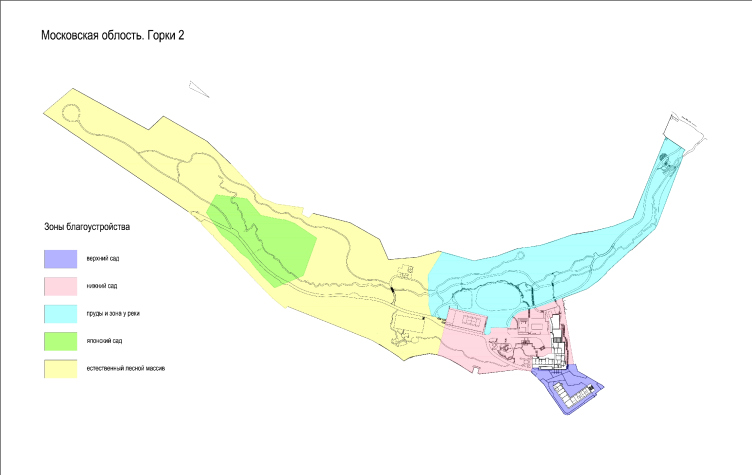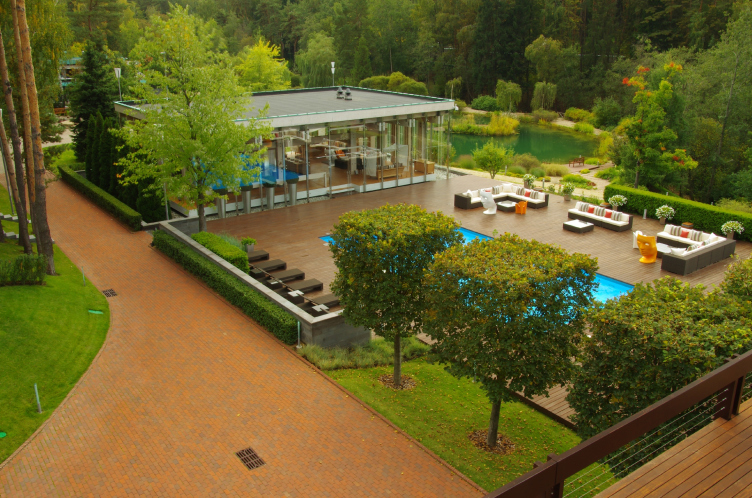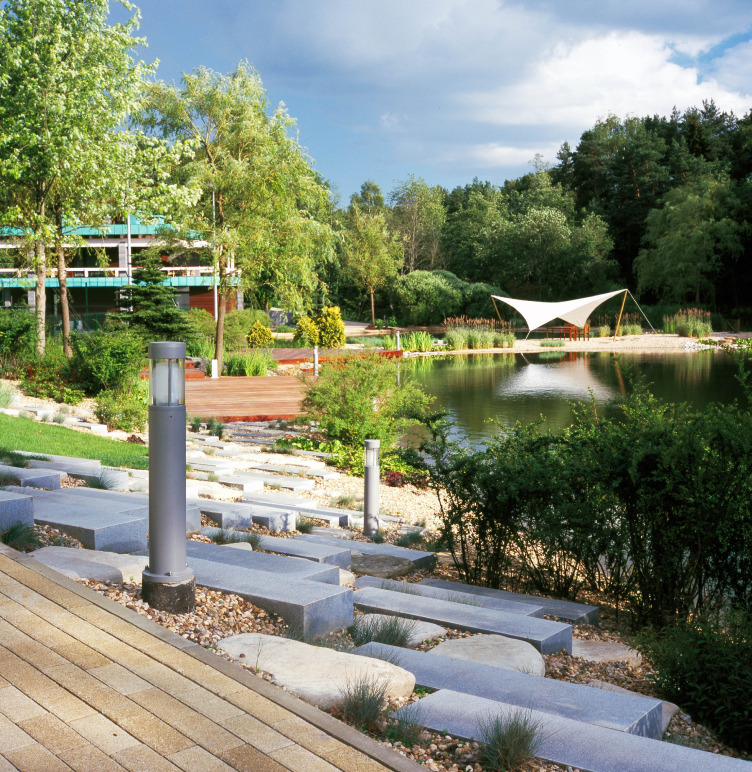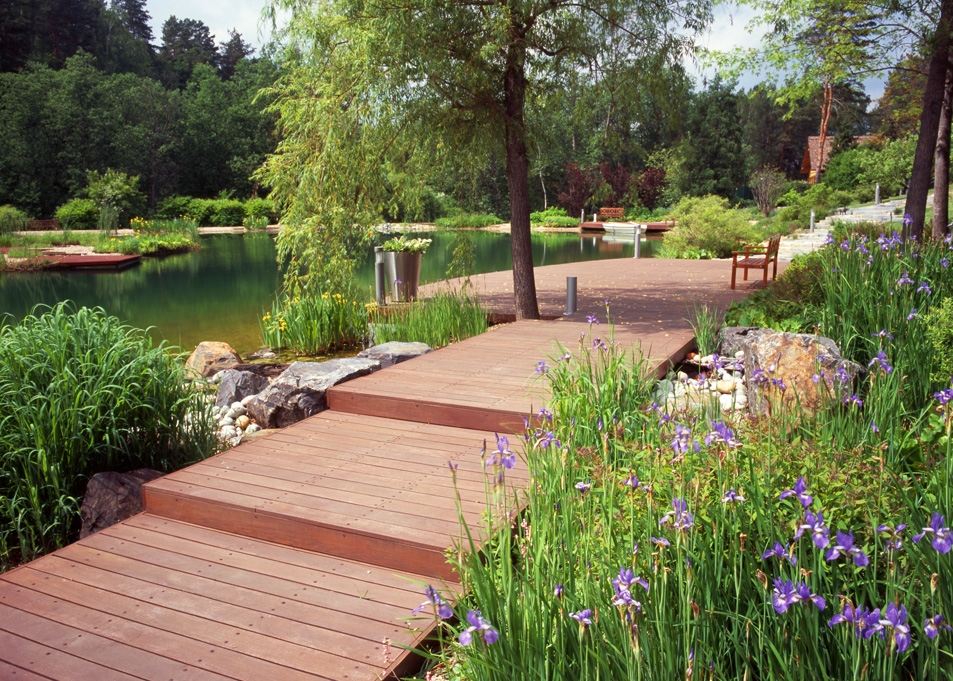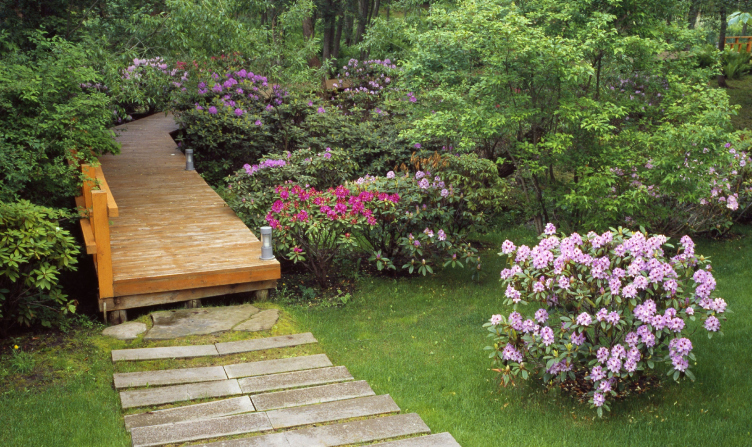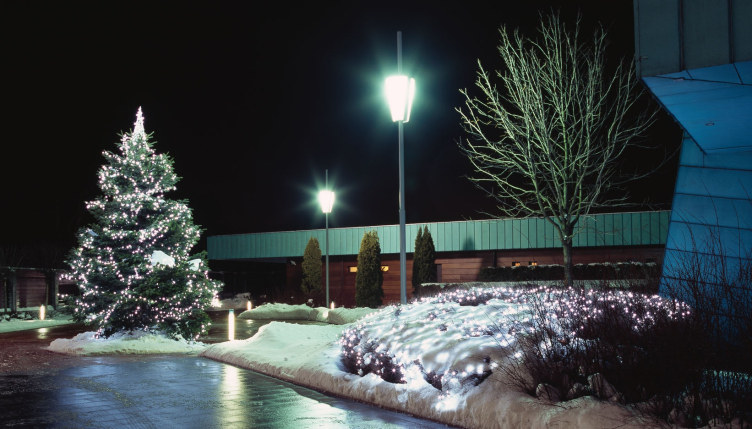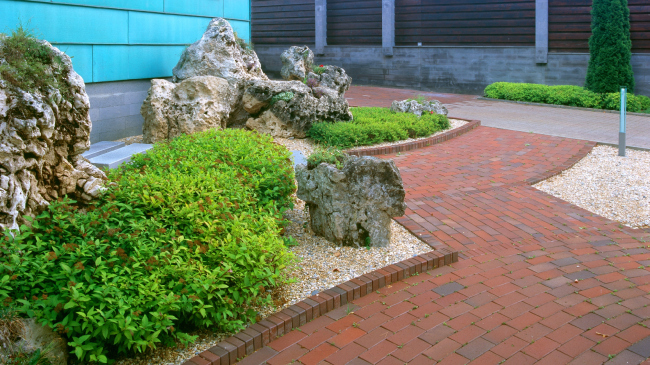
Moscow region. Gorky 2. Frontal Garden © Arteza
The project of "Gorky 2" has been in the process of development by "Arteza" since 2005. It was in that particular year that the owner of the house (at that point being built upon the project of the art group "Kamen" ("Stone")) turned to the landscape architects with a proposal to create on the 11-hectare land site a large and really diverse garden.
The land site that was allotted for organizing the garden is 1.2 kilometers long, and has a natural brook running all along its length. The L-shaped three-story house was built on the section with a considerable relief drop (around 15 meters), and this peculiarity of the land site played the key part both in the composition of the house itself and in the organization of the surrounding garden. Turned south with its main facade, the house cascades down the slope, thanks to which its every floor gets a street exit of its own. Besides the residential building, by the moment the architects started designing the garden there was a large garage complex built closer to the central entrance of the grange, and the slope had a tennis court and an open-air swimming pool cut into it.
It was the unconventional architecture of the house together with the expressiveness of the natural surroundings that became the starting points for forming the garden's design concept, the authors of which from the very start did not want to confine themselves within the boundaries of this or that particular style, and placed their bet of the diversity of the techniques and genres of their landscape architecture. The land site of such impressive dimensions was at once treated by "Arteza" as a congregation of several small-sized "theme" gardens and minilandscapes "built into" the structure of the large garden. The authors themselves call this technique "garden within a garden". The result of this painstaking work is the multidimensional man-made landscape with an ever-changing "exposition": wandering over the territory, one can constantly observe the change of colors, shapes, and ecosystems - from a thick wood to a swampland.

Moscow region. Gorky 2. Layout and zones © Arteza
The land site is divided into several major zones, each of which got a name of its own. Thus, the territory around the garage complex and the main house entrance is occupied by the "Upper Garden", so called because of being located at the topmost point of the site. The territory behind the house, including the swimming pool, the barbecue, the children's playground, the tennis court, and the rocky slope between the top and the bottom level, is called "Lower Garden" by the authors of the project. Right behind it, there is a picturesque territory spreading around the two man-made reservoirs. A separate section is occupied by the "Japanese Garden" that us located near the auxiliary entrance of the grange. This is not all there us to it, though: most of the territory is occupied by the conditional "connecting tissue that the architects endowed with a maximally natural character, keeping intact the areas of the pine forest, the brook that winds among the hills, and the green meadows.
The "Upper Garden" is the one that supports the architecture of the house and the garage complex more actively. Even its materials were selected to match the color of the buildings' finish. The layout of the garden, and especially some of its elements, also rhyme with the edifices. Thus, for example, the "sail" of the garage grows from the round "pillow" of the bushes that are shaped up by the topiary cutting.
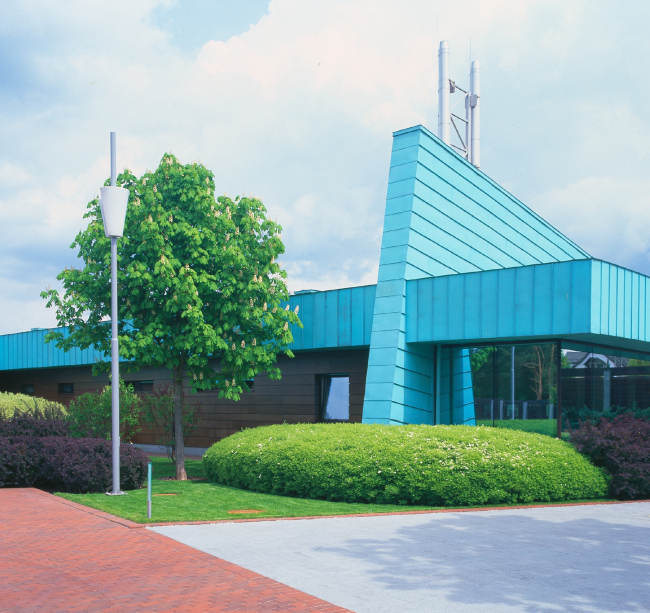
Moscow region. Gorky 2. Upper Garden. The pillow of cotoneaster under the "sail"of the garage complex © Arteza
Inside of the "Upper Garden", not far away from the house entrance, there are two thematic mini-gardens: "Jasper" and "Frontal" - both develop the theme of the Southeast Asia. "Jasper Garden" looks a lot like a seashore, only on a diminished scale, and here the space is dominated by the jasper boulders that are meant to symbolize a rocky shore. The dimply water expanse is simulated by the marble pebbles, while the "shore" - by the thicket of the scrubby cotoneaster and meadowsweet. As the authors share, for this territory even bolder solutions were proposed - for example, instead of the light-colored pebbles it was planned to use blue broken glass - but the customer opted for a more conventional solution.
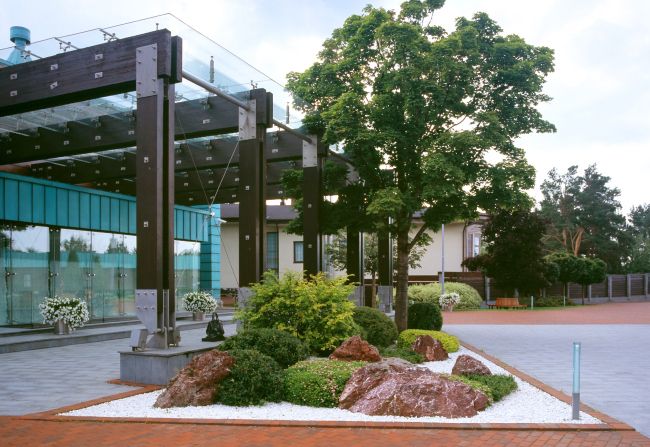
Moscow region. Gorky 2. Jasper Garden © Arteza
The "Frontal Garden" occupies the plot around the corner of the building, along one of its side walls. This place used to be used by the estate owners as a small makeshift passage running along the erosion pavement of the building. With time, it became clear that it would make sense to organize here something like a "junction" or "roundabout" of the most frequently used routes. So it stood to reason that the customer wanted to somehow organize and accentuate this area. As a result, the pavement got covered by a blanket of small pebbles, the place got the beautifully eroded rocks in the Chinese style, and along the edge low-growing spreading shrub was added.
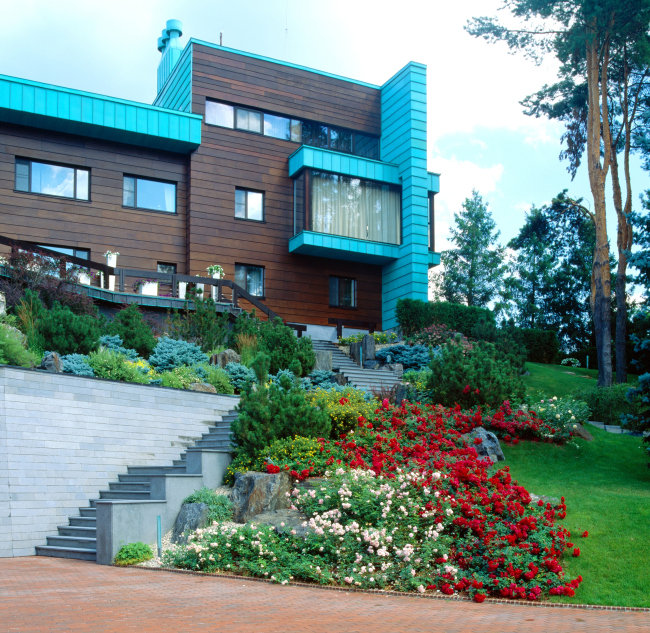
Moscow region. Gorky 2. Lower Garden © Arteza
The "Lower Garden" is probably the most saturated place here that represents a truly diverse assortment of landscape techniques. Particularly interesting is the rocky slope: the authors turned it into a veritable rock that looks as if the very house was cut out of it. To implement this giant-scale idea, tons and tons of rocks were used, the weight of some of them reaching up to ten tons. Down the slope, leading to the terrace of the second level, there runs a picturesque "mountain trail". Around it, there are pine and fir trees, barberries, meadowsweet, and the ground is covered with cover-ground perennial plants. The special "gem" of the slope is the rose house in which the flowers bloom from May till late October.

Moscow region. Gorky 2. View of the Lower Garden from the house © Arteza
At the ascent from the "Lower" to the "Upper" garden, the architects of "Arteza" organized a labyrinth of quaintly trimmed plants that are echoed by the round caps of the bushes and the standard lime trees shaped as parallelepipeds. The lime trees are also to be seen near the swimming pool and the tennis court; they visually separate this territory from the house. At the same time, their austere shape rhymes with the geometry of the house and is also supported by the street furniture, plaited and glass cache-pots, and even cubic lights.
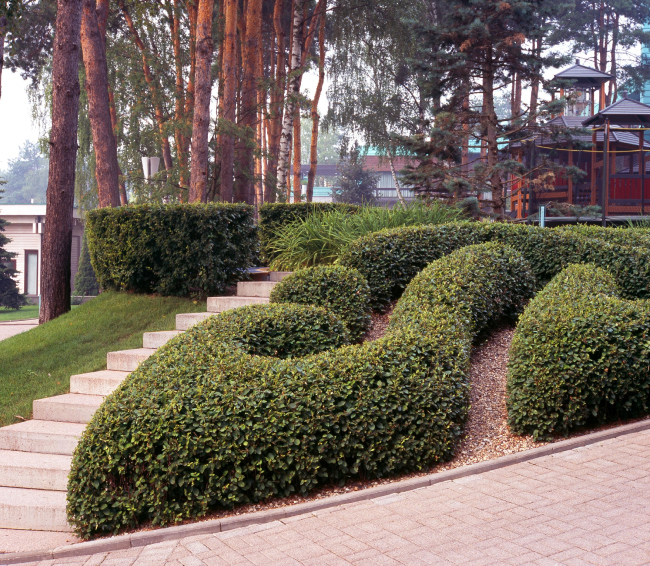
Moscow region. Gorky 2. Lower Garden, labyrinth © Arteza
Getting down, one can find himself in the so called "Zone of ponds and a creek". The central place here is occupied by two large reservoirs separated by a small land bridge. One of these reservoirs is used for swimming, and the other - for breeding fish. For their creation, the architects had to make a rather large mound 3.5 meters high, thanks to which the relief drop between the house and the ponds grew smaller, and as for the brook running through this place, the architects were able to route it under the reservoirs. The bed of the brook that winds down the steep slope was to be turned into a semblance of a mountain river. The territory around the ponds got numerous plants, day lilies, irises, miscanthus, spherical and weeping willows, and into the green banks the architects installed stone slabs that form the access to the water. On the banks of the pond, there are decks for fishing and making picnics, while over the pebbled land bridge the architects stretch a "sail" tent under which the reclining chairs are stowed away.

Moscow region. Gorky 2. Ponds and the river area. Routes leading to the reservoirs © Arteza

Moscow region. Gorky 2. Ponds and the river area © Arteza

Moscow region. Gorky 2. Ponds and the river area © Arteza
Below the ponds, there is a small garden of rhododendrons, crossed by neat planked footways. This looks like some sort of border between the garden and the woodland. Beyond this flourishing garden, both eastward and westward, swampy a forest spreads, that looks nothing like a man-made one, yet one can only guess how much money and effort was invested into its every square meter by the architects and the builders. The green blanket of the grass and the frolicking brook are concealing the sophisticated engineering systems that provide the constant watering, the necessary humidity and the temperature of the soil - but the only thing that reminds of man's intervention on the above-the-ground level is the wooden footways and the straight architectural stairways alternating with the natural ones.

Moscow region. Gorky 2. Ponds and the river area © Arteza
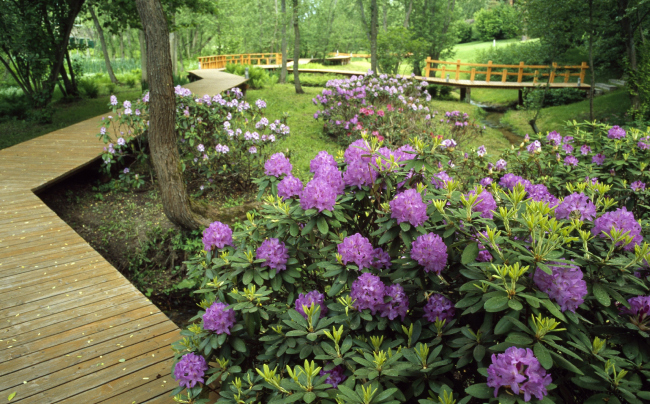
Moscow region. Gorky 2. Ponds and the river area © Arteza
The turf swamp that occupies the whole western side of the land site almost down to the point where it meets the Moskva River, is to be kept intact as a sample of a unique eco system. The swamp turned out to be shallow and not seriously dangerous, so the architects threw over it a wooden bridge upon piles - the bridge supports both pedestrian and automobile traffic. The brook also looks untouched all along its length, even though for its organizing and the strengthening of its banks the architects used some 80 tons of rocks and a plague of various plants. At some places, the brook is crossed by little bridges, and along it runs a bicycle road.
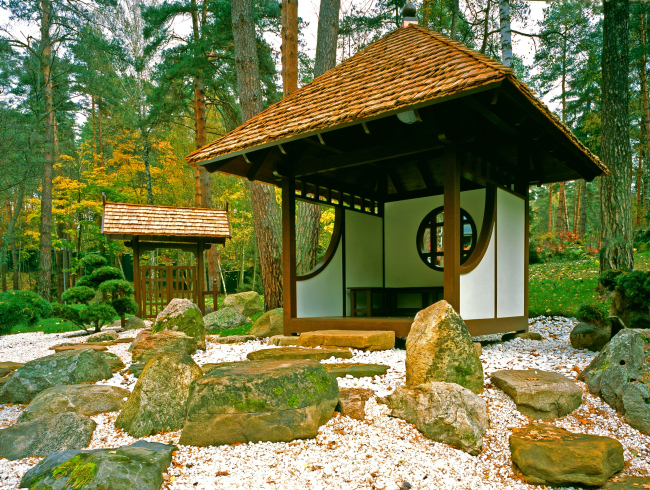
Moscow region. Gorky 2. Japanese Garden © Arteza
Yet another bright element of this "compound" man-made landscape is the "Japanese Garden". Its very appearance was dictated by this place where the brook makes an unbelievably picturesque bend with the scenery of smoothly rising hills covered with fern under the masts of the pine trees. The architects also decided to make the brook wider and deeper turning it into a small creek surrounded by a pile of rocks. Its bank got a meadow a small gazebo and bonsais. Situated in the lowland, the "Japanese Garden" is perfectly viewable from the road leading up to the entrance to the manor.
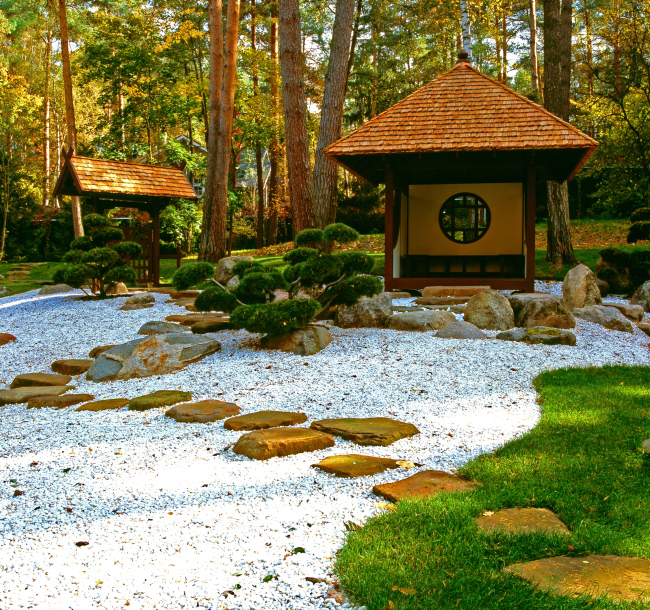
Moscow region. Gorky 2. Japanese Garden © Arteza
It should be specifically mentioned that the main task of the landscape architects was preserving as much as possible the vegetation of their land site. All the gardens were formed around the already-existing natural framework. Today, the garden lives a life of its own, grows, and gains height and color - all this under rigorous supervision of the "Arteza" specialists that have been tending the garden for a whole year now. What is interesting is the fact that in winter the garden leads a life just as active as ever: specifically for the New Year's Day the architects are developing a fairy-tale winter decorations - the ponds turn into a giant skating rink, and the slopes become good for skiing and sleighing.







